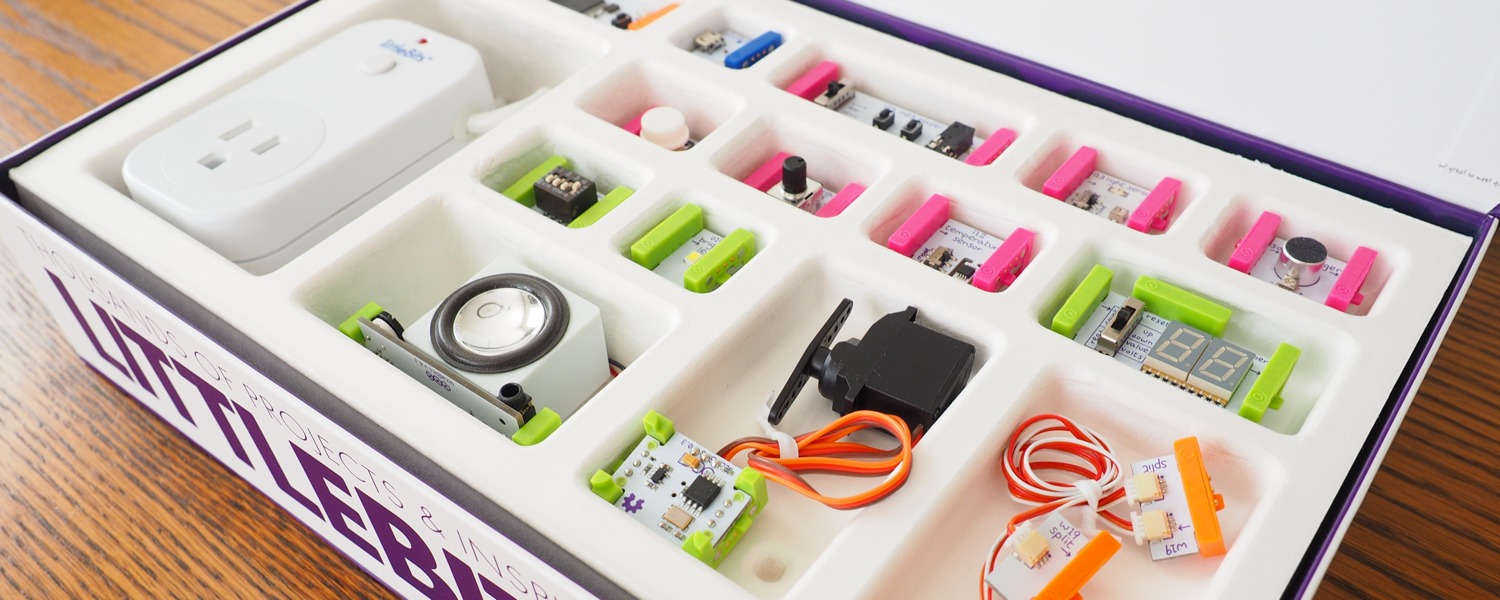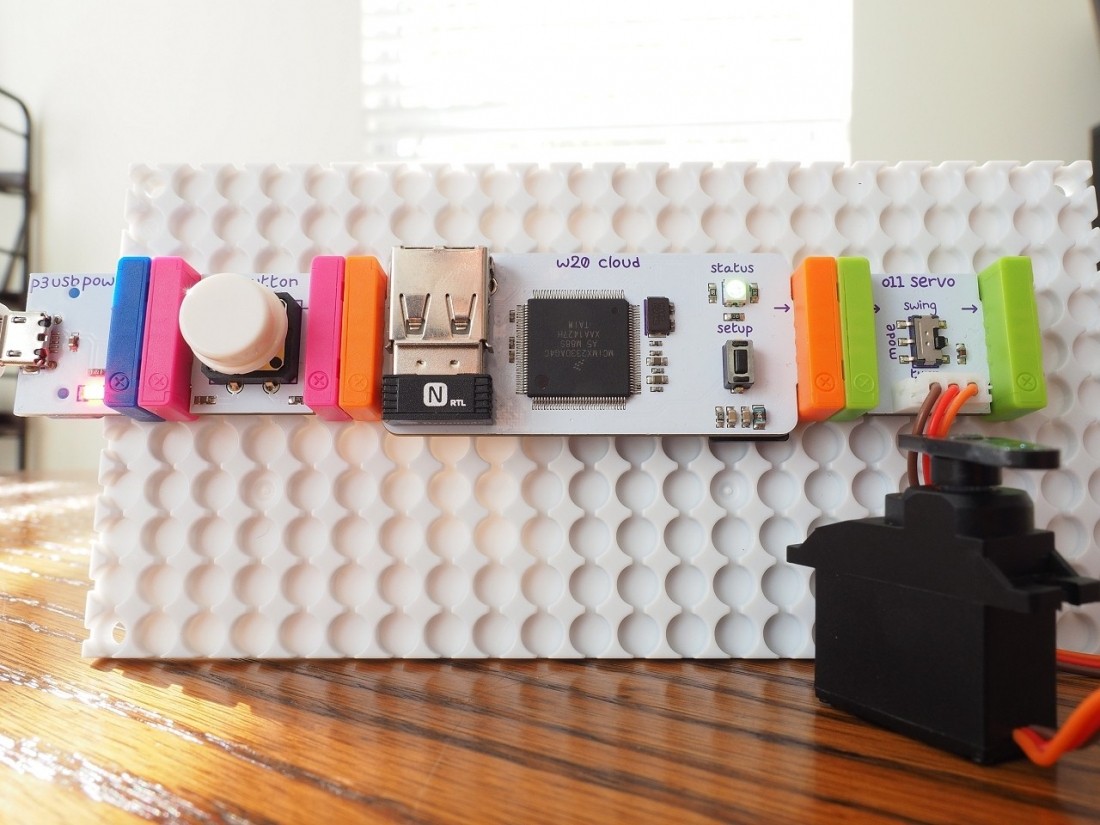Cloud Module: Adding some Internet of Things Functionality
While there's plenty that can be built with the standard modules, the heart of the Smart Home Kit is without a doubt the orange cloudBit, which can be used in one of three ways.
In cloudBit to web mode, you can use the hardware to communicate with web services and software. For example, a button press can trigger an SMS, a tweet or even log data into a spreadsheet. Configured in web to cloudBit mode, data from the web can be sent down to your littleBits hardware. An example of this would be keeping a tally of each Instagram like using the number module. And in the event you have more than one cloudBit, you can configure them to talk to each other so one machine can control another.
Before getting started with the cloudBit, you'll need to run through a quick one-time setup process that'll assist in connecting the cloudBit to your local Wi-Fi network. This can be done on any Internet-connected computer or smartphone and took just a couple of minutes to complete.
With the cloudBit connected to my Wi-Fi network, it was time to build my first IoT circuit consisting of the USB power module, cloudBit, IR transmitter module and bright LED module. I also used the AC switch for this build, plugging a lamp into it. By accessing the littleBits Cloud Control website on my smartphone, tapping the button icon under the "Send" tab would send a command to my cloudBit to turn the lamp on and off.
Creating an account at If This Then That (IFTTT) really opens the doors for all sorts of automated projects. IFTT is a service that lets you create recipes to connect your circuits to various Internet services using the cloudBit. It sounds a bit complicated but it's all very easy as there's already a littleBits channel on IFTT where you'll find more than a hundred recipes from other users that you can implement with your own hardware.
To test it out, I created an SMS doorbell using the USB power module, the button module, bright LED module and the cloudBit. I then used IFTTT to create a recipe that would send a text message to my phone whenever the button was pushed. It worked as advertised.
Next, I created a laundry done alert circuit comprised of the USB power module, sound trigger module, bright led and cloudBit. With IFTTT, I set up a recipe to send an SMS whenever the sound trigger tripped. You can fine-tune the sensitivity via the small potentiometer using the included screwdriver. Just like the SMS doorbell, this also worked without incident.
It's worth pointing out that, as per IFTTT guidelines, you're only allowed 100 SMS text messages each month so if you do plan to use a circuit long-term, make sure it's not something that'll exceed this limitation.
Another circuit I built was designed specifically for a problem I've been having lately. The latest update for my Nest thermostat appears to be a bit flawed in that, sometimes, the thermostat appears offline from my phone (usually at night when I'm ready to go to sleep and want to adjust the temperature).
The only way for it to "reconnect" is to physically approach the thermostat. Once the proximity sensor picks up movement, the thermostat wake up, reconnects and I can control it from my phone as usual. Since I'm already in bed and comfortable, the last thing I want to do is get back up to fix it. But with littleBits, I can remedy the situation until Nest issues a patch.
Using the USB power module, button, cloudBit and servo, it'd be a breeze to rig up a contraption that - using the servo - would dangle something in front of the Nest to wake it up. All of this, of course, would be done on my smartphone from the comfort of my bed.
Usage and Thoughts
littleBits is one of those rare products that simultaneously caters to multiple demographics.
As an educational tool, littleBits really got the creative juices flowing. Even after I'd finish a session, I found that my brain kept trying to come up with new projects that I could build to solve real-world problems.
For it to stimulate my adult brain in such a way is noteworthy and I can only imagine that it'd have a similar effect on children. Being exposed to a product like this at a young age has the potential to open all sorts of creative doors and perhaps even get more people interested in the fields of electronics, mathematics and so forth.
It's also worth pointing out that littleBits never felt like a kid's toy to me. Sure, it's easy to use and darn near fool-proof but at the same time, you can make it as complex or as simple as you want. It scales very well based on the skill level of those interacting with it.
As for the modules themselves, everything seems to be top quality. None of the modules felt cheap or as if they'd break in a short period of time. The white PCB has a very modern look and the magnetic system worked as it should, allowing you to easily snap together modules in the correct orientation. Try to connect the wrong ends of two bits and you'll feel the repulsion of the two similar poles - very neat.
The 14 modules included in the Smart Home Kit are just a fraction of littleBits' current inventory, each selected for their penchant for home automation. There are dozens upon dozens of other modules that can be purchased to expand your collection which leads me to one of the few drawbacks I found with littleBits: the price.
Simply stated, littleBits aren't cheap. The Smart Home Kit I tested retails for $249 - you can get a high-end smartphone on subsidy or even a Chromebook for less than that. If you're looking to jump in at a lower price, the Base Kits starts at $99 and includes 10 modules with three accessories. It doesn't, however, include the cloudBit - a $59.95 module when sold separately that's necessary if you want IoT functionality.
Another option would be to go the a la carte route and hand-pick only the modules you'd need for a given project or ones you think you'd get the most mileage out of.
Some would argue that $100 is a drop in the bucket to better a child's education, and I completely agree. But for others just looking to tinker around, it can become an expensive hobby in a hurry. At times, I found myself wishing I had some additional modules to build with.
As for the Smart Home Kit itself, it's probably best reserved for someone looking to try out a bunch of different home automation devices before splurging any money on permanent gadgets. For example, the wireless light control I built - while immensely cool, you can purchase a hub and a handful of connected light bulbs for far less than what this kit costs. The same goes for the clapper machine; these can be had for under $20 and have been around for ages.
Along that same train of thought, some of the littleBits projects and tutorials found online were outright cheesy or impractical. Examples include the candle killer, the hot coco stirrer and toilet paper inventory. Meanwhile, some popular IFTTT recipes you may or may not find useful include pet feeders that can be scheduled or triggered via email, keeping a record of everytime your cat uses the pet door, and a recipe to light up your umbrella holder when it's raining outside.
One annoyance I did come across, although not major, is the fact that not all of the URLs for the sample projects in the quick start guide worked. It seems that their URLs have changed since the guide was printed and littleBits hasn't set up redirects for all of them.
My only other suggestion would be to perhaps include an enclosure or two to go along with the mounting boards. Someone with a 3D printer could easily make their own but for the rest of us, building a permanent enclosure for a project would take a bit of time and skill.
All things considered, if the price isn't a barrier, littleBits would make a great gift for a child or the teenage / adult tinkerer in your life.








